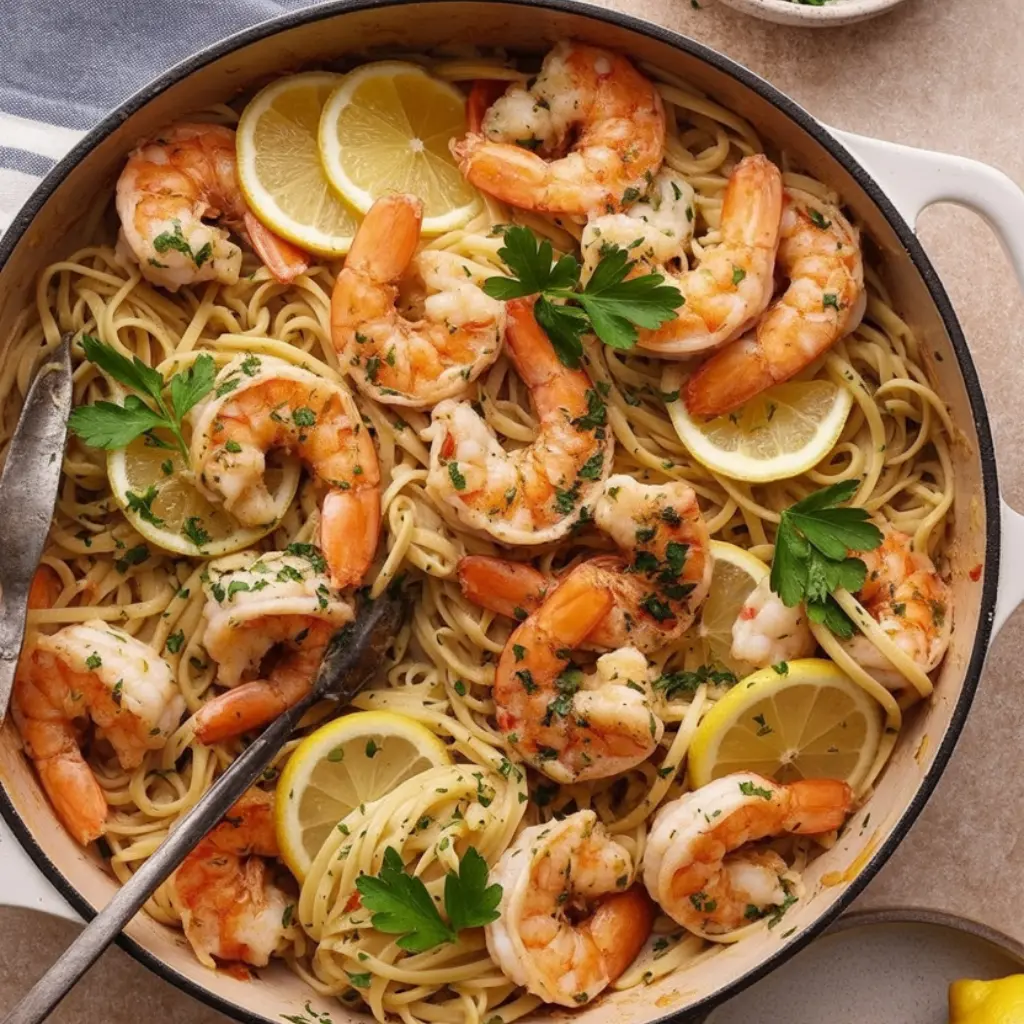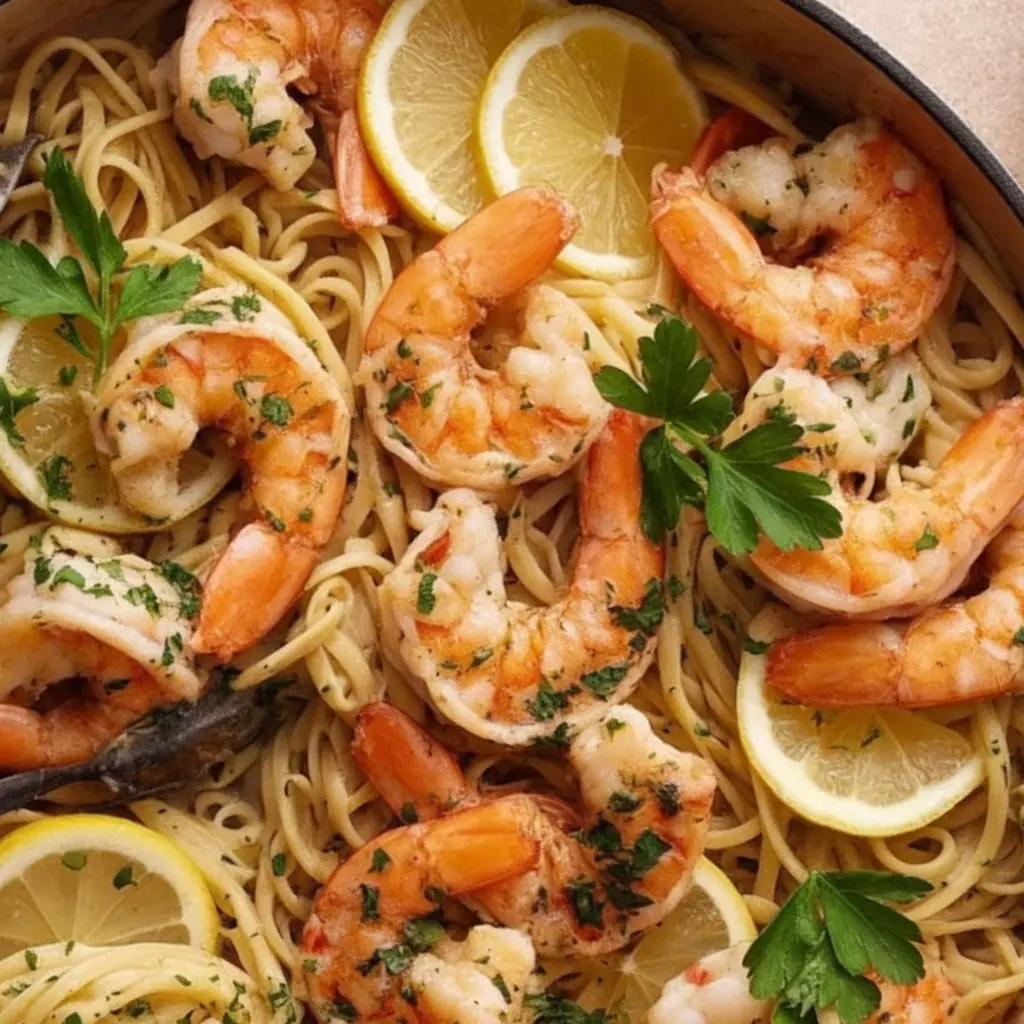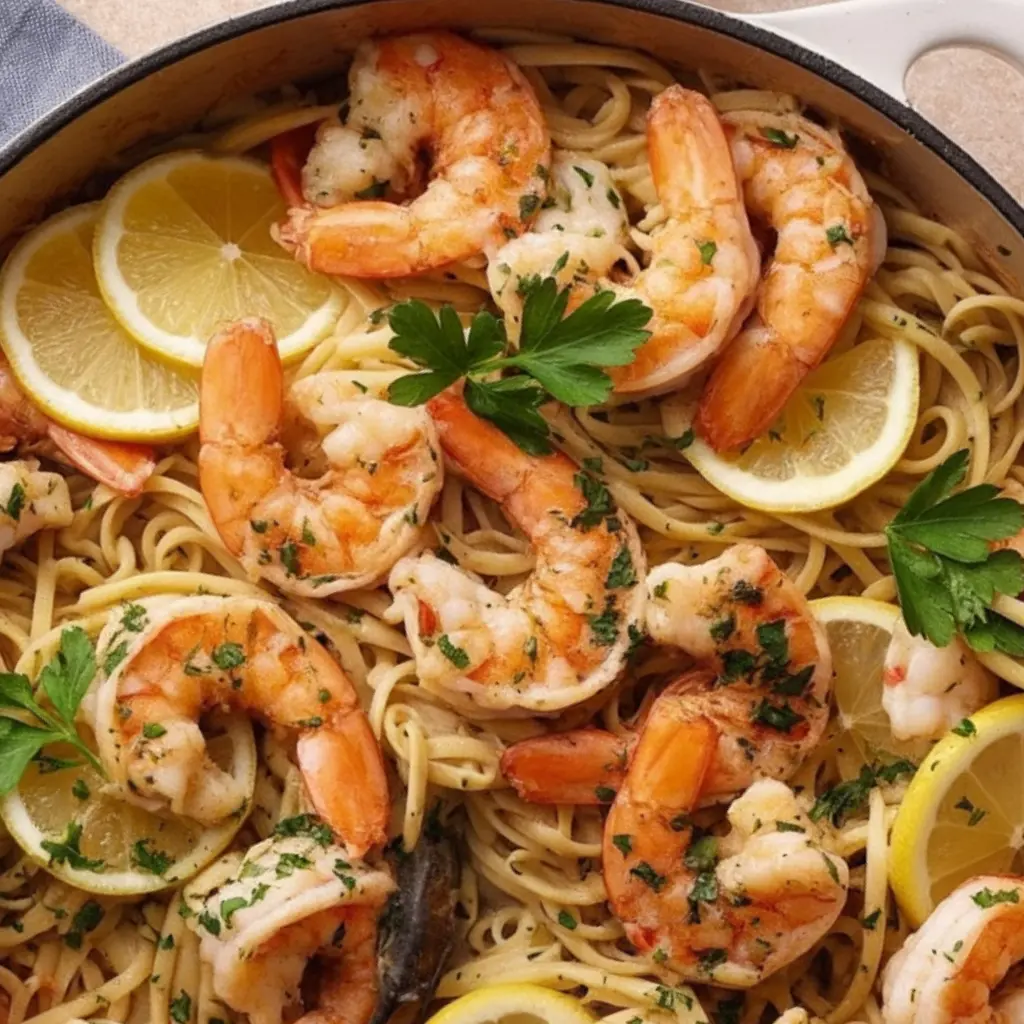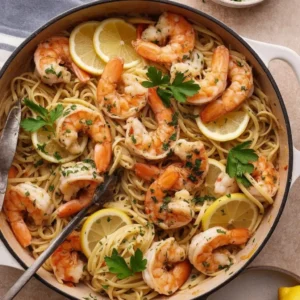I still remember the night I fell for shrimp scampi. I was newly married, standing in a small apartment kitchen with a skillet that had seen better days, determined to make something that felt a little fancier than our usual weeknight fare. We couldn’t afford dinner out, but I’d splurged on a bag of shrimp from the seafood counter because I’d read somewhere that “shrimp scampi is effortless elegance.” The truth? My first attempt was a disaster—garlic scorched, pasta gummy, shrimp rubbery enough to bounce.
My husband was polite, but I could see him chewing like it was a workout. That failure stuck with me, and over the years I became determined to make scampi properly—learning when to add the garlic, how not to overcook the shrimp, and how to coax just enough butter and lemon into the sauce so it tastes like something from a seaside bistro. Now it’s the dish I reach for when I want comfort, speed, and just a bit of romance in the kitchen.

Why You’ll Love This Recipe
- Quick to prepare—perfect for weeknights but elegant enough for guests
- Full of bright, garlicky, lemon-butter flavor
- Uses simple, easy-to-find ingredients
- Flexible and forgiving—you can make it your own
- Pairs beautifully with pasta, rice, or crusty bread
Ingredients You’ll Need
- Shrimp – I like large shrimp (16/20 count) because they stay tender and give the dish some presence. Fresh is wonderful, but frozen works just fine if you thaw them properly. I always peel and devein them for the best eating experience.
- Butter – Real, unsalted butter is essential here; it forms the base of the sauce. I’ve tried using margarine once in a pinch—never again.
- Olive Oil – A good extra virgin olive oil adds depth and prevents the butter from burning.
- Garlic – Freshly minced. I used pre-minced once out of convenience and regretted it; the flavor just isn’t the same.
- Dry White Wine – Something crisp and drinkable, like Pinot Grigio or Sauvignon Blanc. If wine’s not an option, chicken broth makes a decent substitute.
- Lemon Juice – Freshly squeezed for the brightness that balances the butter. Bottled lemon juice tastes flat here.
- Red Pepper Flakes – Optional, but they add a gentle warmth without making it spicy.
- Fresh Parsley – Chopped and sprinkled in at the end for color and freshness.
- Salt & Pepper – Always to taste, but don’t skimp; seasoning is everything.
- Pasta – I often use linguine or spaghetti, but you could skip pasta entirely and spoon the scampi over rice or even sautéed greens.
How to Make It (Step-by-Step Instructions)
Start by bringing a pot of well-salted water to a boil if you’re serving this with pasta. I always salt my pasta water until it tastes like the sea—it’s the first step to ensuring the final dish is flavorful. While the water heats, pat your shrimp dry with a paper towel. This might seem fussy, but it helps them sear instead of steam. I season them lightly with salt and pepper at this stage.
In a large skillet, warm the olive oil and half of the butter over medium heat. The olive oil keeps the butter from browning too quickly. Once the butter has melted, add the shrimp in a single layer. They only need about a minute or two per side—just until they turn pink and opaque. If you overcook them here, they’ll turn rubbery, so I take them out as soon as they’re just done and set them aside on a plate.
Now for the garlic: I lower the heat slightly before adding it to the pan. Garlic burns faster than you think, and once it’s bitter there’s no saving it. Stir it around for about 30 seconds, just until fragrant, then splash in the white wine. The pan will sizzle and steam—that’s your cue to scrape up all those golden bits from the bottom. Let the wine simmer for about two minutes, reducing slightly, before whisking in the remaining butter and the lemon juice. The butter will melt into the wine and create that luscious, glossy sauce you’re after.
If I’m serving this with pasta, I add the drained pasta directly into the skillet, tossing it in the sauce so every strand is coated. The shrimp go back in at the very end, just to warm through, along with parsley and a pinch of red pepper flakes if I’m in the mood. Everything should be glossy, aromatic, and begging to be served immediately.

Expert Tips for the Best Results
Shrimp scampi is as much about timing as it is about flavor. The shrimp cook in minutes, so keep your focus on the pan and resist the urge to walk away. Always cook the garlic gently—too much heat, and you lose its sweetness. Don’t be afraid of butter here; it’s the heart of the sauce, but balance it with enough lemon juice to keep things lively. And finally, taste as you go. A pinch more salt or an extra squeeze of lemon at the end can take it from good to truly restaurant-worthy.
Variations & Substitutions
I’ve made shrimp scampi with chicken when shrimp wasn’t in the budget, and while it’s not the same, it’s still delicious. One winter night, I swapped white wine for dry vermouth because that’s what was in the cabinet, and it added an herbal depth I didn’t expect. I’ve tossed in cherry tomatoes, spinach, even zucchini ribbons when I needed to use them up. Sometimes I skip pasta altogether and serve the scampi over mashed potatoes, which soaks up that buttery sauce in the best way. The beauty of this dish is that it forgives your substitutions and often rewards them.
Serving Suggestions
Shrimp scampi shines as a main dish, but I’ve served it as part of a larger spread for friends—think a big salad, warm crusty bread, and maybe a chilled bottle of that same wine you cooked with. It’s perfect for date nights when you want something special without spending all night in the kitchen. On summer evenings, I take it outside and pair it with grilled vegetables; in the winter, I serve it over creamy polenta for something cozier. It’s as versatile as it is beautiful on the plate.
Storage & Reheating Instructions
Leftovers keep surprisingly well if stored in an airtight container in the fridge for up to two days. The sauce will firm up as it chills, but it loosens nicely when gently reheated in a skillet over low heat. I avoid the microwave for shrimp—it tends to make them tough—so I warm the pasta and sauce first, then add the shrimp just until heated through. The flavor holds, though the shrimp will never be quite as tender as when first cooked.
Recipe FAQs
Can I make this ahead of time?
You can prepare the sauce a few hours in advance, then quickly cook the shrimp just before serving. Shrimp taste best fresh from the pan.
Do I have to use wine?
Not at all—chicken broth works well, though it won’t have quite the same depth.
What kind of pasta works best?
Linguine is my favorite because it holds the sauce beautifully, but spaghetti or angel hair work fine.
Can I use frozen shrimp?
Absolutely. Just thaw them completely and pat them dry before cooking to avoid excess moisture.

Conclusion
Shrimp scampi has taught me that even the simplest dishes can feel like an occasion when made with care. Whether you’re cooking for one, a family dinner, or someone you’re trying to impress, it brings a certain grace to the table without demanding too much from you. I hope you give this version a try, make it your own, and maybe even start your own kitchen tradition with it. If you do, I’d love to hear how it turned out—because in the end, the best recipes are the ones we share.
Nutrition Information (per serving, based on 4 servings):
Calories: 420 | Protein: 28g | Fat: 18g | Carbohydrates: 36g | Fiber: 2g | Sodium: 740mg

Shrimp Scampi
Ingredients
- 1 lb large shrimp peeled and deveined
- 3 tablespoons unsalted butter
- 2 tablespoons olive oil
- 4 garlic cloves minced
- ½ cup dry white wine or chicken broth
- Juice of 1 lemon about 2 tablespoons
- ½ teaspoon crushed red pepper flakes optional
- Salt and black pepper to taste
- ¼ cup chopped fresh parsley
- 12 oz linguine or spaghetti optional, for serving
- Extra lemon wedges for serving
Instructions
- Cook pasta (if serving with pasta): Bring a large pot of salted water to a boil and cook linguine until al dente. Drain and set aside.
- Sauté garlic: In a large skillet, heat olive oil and 2 tablespoons of butter over medium heat. Add garlic and cook until fragrant, about 1 minute.
- Cook shrimp: Add shrimp, season with salt, pepper, and red pepper flakes. Cook 1–2 minutes per side until pink and opaque. Transfer shrimp to a plate.
- Make sauce: Pour wine (or broth) into the skillet, scraping up any browned bits. Let it simmer for 2–3 minutes until reduced slightly. Stir in lemon juice and remaining butter.
- Combine: Return shrimp to the pan, toss with sauce, and stir in fresh parsley.
- Serve: Spoon shrimp and sauce over pasta or serve with crusty bread and extra lemon wedges.
Notes
- Wine substitute: Use chicken broth if avoiding alcohol.
- Pasta alternative: This dish is also delicious over rice, zucchini noodles, or with just bread.
- Make it creamy: Stir in a splash of heavy cream for a richer sauce.
- Quick tip: Don’t overcook the shrimp—they cook fast and can turn rubbery if left too long.

